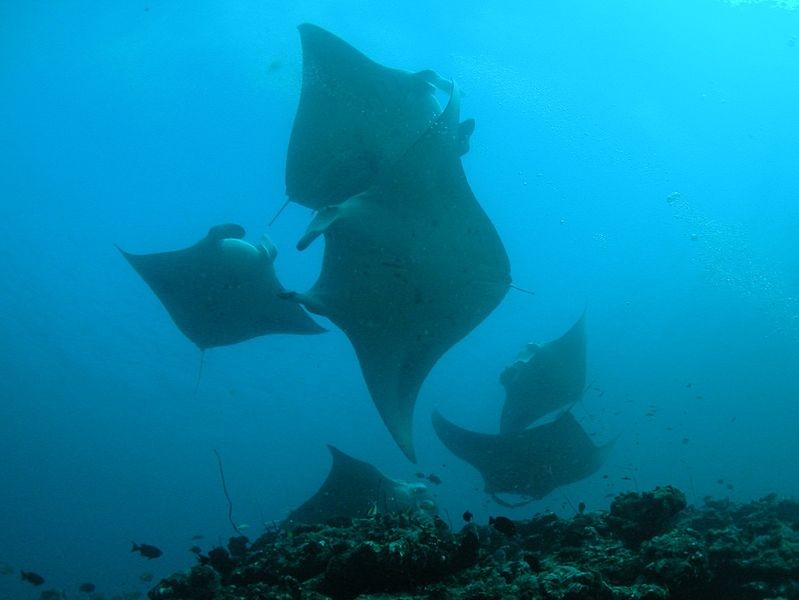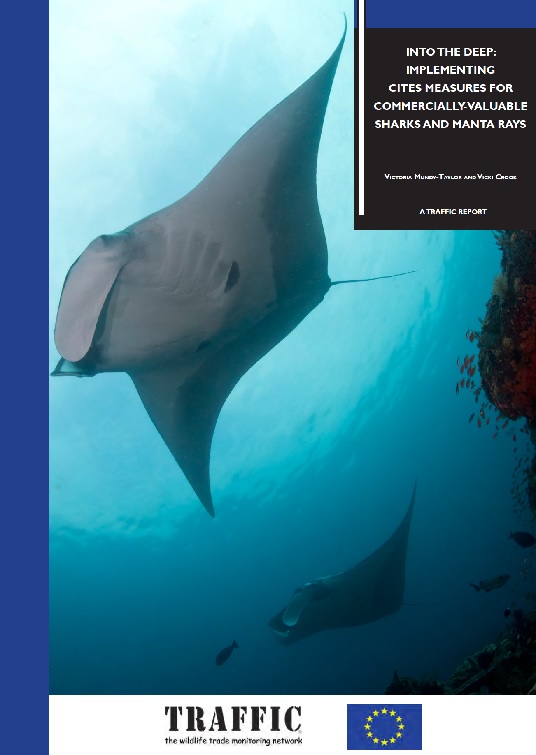New Study Gets its Teeth Into Shark Trade Regulations

A new TRAFFIC study examines how implementation of trade controls through CITES regulations can ensure that seven species of sharks and manta rays are only sourced sustainably and legally before entering international trade.
The study, Into the deep: Implementing CITES measures for commercially-valuable sharks and manta rays (PDF, 1.8 MB) was commissioned by the European Commission and written in the wake of the shark and manta ray species being listed within the Appendices of CITES (the Convention on International Trade in Endangered Species of Wild Fauna and Flora) at a meeting held in Bangkok, Thailand, in March this year.
They include the Oceanic Whitetip shark, Porbeagle shark, three species of hammerhead shark (Scalloped, Great and Smooth) and manta rays, all of them subject to continued over-exploitation. The species are all slow growing, late to mature and produce few young, making them highly susceptible to over-fishing.
“There was great elation when these sharks and manta rays were listed in CITES this March, but although it was a significant moment for the conservation world, now comes the task of making these listings work in practice as time is running out for some of these species,” said Glenn Sant, TRAFFIC’s Marine Programme Leader.
“CITES listings do not take away the need for comprehensive fisheries management, they represent one critical part of that management through aiming to control trade and prevent international trade in products of these species being sourced from unsustainable or illegal fisheries.”
Mr Hugo Schally, Head of Unit in the Directorate-General for Environment of the European Commission said: “This report provides a comprehensive picture of the situation of the sharks and rays listed at the last CITES Conference of the Parties as well as of the challenges ahead to ensure that international trade in those species becomes sustainable.
“It also shows that many countries and stakeholders are working together and planning joint activities to ensure proper implementation of the CITES shark and ray listings.
“This information will prove very useful to the EU which granted €1.2 Million to the CITES secretariat to carry out a capacity-building programme specifically targeted at countries involved in the harvest of and trade in CITES-listed sharks and rays.”
The new listings have been delayed coming into effect until 14th September 2014, to give CITES Parties adequate time to prepare for their implementation, including guidance for range States on how to determine what levels of trade are sustainable for the species concerned—a requirement under CITES for trade to be permitted.
 The new study aimed to identify: which of the 178 CITES Parties will mainly be affected by the listings; the relevant existing international, regional and domestic regulations; the main challenges facing implementation of the measures; and any additional capacity building needs to ensure those Parties catching and trading in the products of these species can validate their sustainability and legality before issuing permits.
The new study aimed to identify: which of the 178 CITES Parties will mainly be affected by the listings; the relevant existing international, regional and domestic regulations; the main challenges facing implementation of the measures; and any additional capacity building needs to ensure those Parties catching and trading in the products of these species can validate their sustainability and legality before issuing permits.
The study revealed a lack of basic information on the levels of catch and population status of the newly listed marine species, with an urgent need to improve the identification of species in trade, reporting of their trade and for further research, assessment and monitoring to determine the impacts of trade on populations. The study also highlighted the need to ensure domestic regulatory frameworks and administrative structures are adequate to support the implementation of CITES trade controls.
The study also examined the very different dynamics influencing the trade in the species concerned—the manta rays are chiefly traded for their gill rakers, used in traditional Asian medicines, while Porbeagle is mainly caught for its meat, hammerhead sharks caught both for local consumption of their meat and international trade in their fins and the larger Oceanic Whitetip caught for its highly valued fins, destined for markets in East Asia, particularly Hong Kong.
Some of the species examined are specifically targeted by fishing operations, while others are a secondary, but valuable, catch when targeting other species such as tuna. Given the different markets involved in the trade and uses involved, this creates highly complex trade chains which the new study attempts to unravel.
“Key to implementing the CITES regulations will be the establishment of chain of custody measures to facilitate enforcement and verification that harvest is legal,” said TRAFFIC’s Research Officer, Victoria Mundy-Taylor, co-author of the new study.
“Trade regulation is fundamental to the management of these shark and manta ray species in our oceans, without it their numbers will continue to decline to perilous levels.”
Last month, the European Union banned the practice of shark finning by EU vessels entirely, in response to the devastating impact over-fishing is having on some shark species, while Brunei recently announced a ban on catching and landing of all shark species and several airlines, including Air New Zealand, Cathy Pacific, Korean Air, Qantas and Seoul-based Asian Airlines, have recently announced bans on the carriage of shark fin.
Note:
The Top 20 shark catchers in descending order are Indonesia, India, Spain, Taiwan, Argentina, Mexico, United States of America, Malaysia, Pakistan, Brazil, Japan, France, New Zealand, Thailand, Portugal, Nigeria, Islamic Republic of Iran, Sri Lanka, Republic of Korea and Yemen, who between them account for nearly 80 percent of the total shark catch reported globally, with Indonesia and India alone responsible for over 20% of global catches between 2002 and 2011. Three EU Member States - Spain, France and Portugal - are among the top 20 shark catchers, responsible for 12% of global catches and, collectively, the 28 EU Member States are the largest shark catching entity of all.
Photo by TANAKA Juuyoh



